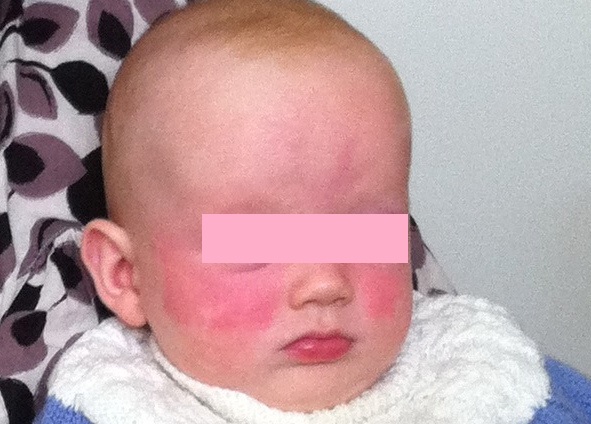Neonatal lupus erythematosus
What is neonatal lupus?
Neonatal lupus is an autoimmune disease. It occurs when an antibody is transferred from the mother to the baby. The antibody can affect the baby’s skin, heart, liver, blood and brain. Neonatal lupus is rare with an incidence of 1 in 20,000 pregnancies. It most commonly presents with skin rashes or heart block (where the electrical signals in the heart are disrupted). Most mothers (60%) do not have any symptoms and are often unaware that they have a circulating autoantibody.
What causes neonatal lupus?
Neonatal lupus is caused by a circulating autoantibody. In approximately 80% of cases, the Ro antibody is positive. In 50% of cases, the La antibody is positive. In a recent retrospective review from Thailand, 100% of reported mothers had an antinuclear antibody (ANA) in their blood. This is the antibody found in a number of autoimmune conditions such as lupus erythematosus or Sjogren’s syndrome. In rare cases an anti U1RNP antibody is present.
What does neonatal lupus look like?
Neonatal lupus in the skin can resemble skin lupus seen in adults.
In most cases red, ring-like lesions are seen on the skin. They may be scaly in areas affected by the sun. The image below shows the classic periocular (“raccoon eye” or “owl eye”) erythema.

The classic onset of neonatal lupus is 1 to 2 months of age (although it can be present at birth).
After the rash resolves, some children have residual post-inflammatory pigmentation, prominent blood vessels (telangiectasias) and pale scar-like areas.
There is heart disease in approximately 60% of cases and this is the major cause of the 10-30% mortality rate. Congenital heart block, heart failure and structural heart defects are seen. However, a slow heart beat is usually picked up before birth on the 18 week ultrasound. If it is not present at birth it is much less likely to be a problem.
Liver abnormalities are seen in around 50% of cases and blood abnormalities in 35%. In rare cases aseptic meningitis, myelopathy and pneumonitis are present.
How is neonatal lupus diagnosed?
Diagnosis is confirmed with blood tests of both mother and baby. The blood tests will distinguish it from other conditions which may resemble neonatal lupus such as: other photosensitive dermatoses (including genodermatoses); atopic dermatitis and seborrhoeic dermatitis; tinea; urticaria; acute haemorrhagic oedema of infancy; or erythema multiforme.
A skin biopsy may not be needed if the baby has the classic ring shaped rash, and the mother has the typical blood test findings.
What other tests may be needed?
For the child with confirmed cutaneous (skin) neonatal lupus, a physical examination including monitoring of the heart rate is required. An electrocardiogram may be required. Screening for other forms of the disease is recommended with blood tests such as full blood count, kidney and liver function tests. The child may need to be referred to a paediatric rheumatologist and cardiologist.
How is neonatal lupus treated?
- Cutaneous (skin) disease
Sun protection is important and mild topical steroids can be trialled for skin lesions if discomfort is present or for cosmetic reasons. Pulse dye laser treatment may be used for residual telangiectasias.
- Other organ disease
Depending on the degree of organ involvement, oral or systemic steroids may be required. Cardiac involvement may require pacemaker placement or medication to treat heart failure. Structural defects may require surgical management.
- Mothers
Referral to an immunologist or rheumatologist with experience in this area is required to evaluate active autoimmune disease and discuss management of future pregnancies. Preconception oral plaquenil can reduce the risk of neonatal cardiac lupus and, if detected during pregnancy, IVIG, oral prednisolone or plasmapheresis may be given. Close ultrasound monitoring of the foetus is required.
This information has been written by Dr Rachael Foster
Updated 15 June 2015